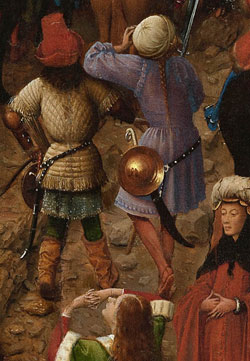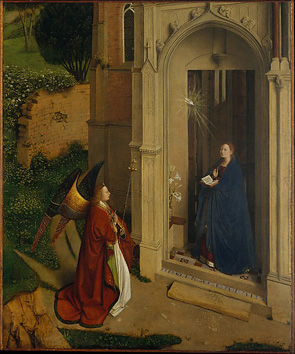The Missing Pieces
John Haberin New York City
Jan van Eyck: Crucifixion and Last Judgment
One of the delights in looking at art is stepping back to see it as a whole. And one of the pleasures of art history is filling in the missing pieces. With a glorious pair of paintings most likely by Jan van Eyck, the missing element may lie at the work's very center.
An earlier owner sure thought so. When the Russian sold the paintings more than a hundred years ago, he called them the wings of an altarpiece. The central panel, he explained, had been stolen. It has never turned up and, it is safe to say, never will. New clues have appeared, though, in just the last few years. Suffice it to say that they add puzzles of their own. 
Who painted it?
The Met has had several exhibitions of single works from the collection, in context of related works and their background. Others have focused on Francisco de Goya, Lucas Cranach, and Andrea del Sarto. They offer the occasion to take one's time, unlike in a blockbuster, and to make one's own rediscoveries. Call them the ultimate in "slow art." This one goes back to one of the very first painters in oil and the very model for the Northern Renaissance. And the puzzles only begin with the work's original condition.
For starters, just who painted it—and when? The panels show the Crucifixion and Last Judgment, in the glowing colors and exquisite detail associated with Jan van Eyck. Quite a crowd assembles at the base of the three crosses, in grief or triumph. Any one of the figures is worth approaching to take in its surfaces and its story. An entire city appears in the distance, beneath mountains and clear skies. The Last Judgment rises from the dense chaos of hell to a skeleton sweeping forward like a bird of prey, Saint Michael, nude men and women rising from their graves and the sea, an orderly assembly of the saved, a young god, and his angels.
Several closely resemble figures elsewhere by van Eyck, including a turbaned woman of formidable reserve. She faces away from the Crucifixion, as if to pass judgment on both an agonized Mary Magdalene and the viewer. At the same time, nowhere else does van Eyck become lost in a crowd, rather than in the vision of a precious ceremony. And everywhere else perspective cements that vision with its unity. Yet here the foreground rises vertically, the middle ground occupies a shallow stage, and the top plummets into depth. One can think of each panel as three distinct scenes, each of separate interest.
Not a bad compositional device, but for the van Eyck? It feels like a compromise with earlier ideals, and sure enough the Renaissance came around to cleaning it up. The Met has borrowed another pair of paintings, these by his star pupil, Petrus Christus. There the left panel has, at top, an Annunciation set in Mary's bedroom with a view out the window, all in perfect perspective. Below, the adoration of the infant Jesus has the artist's usual warmth, with a very human Saint Joseph dwarfing three angels and accompanied by a noblewoman, perhaps the painting's sponsor. And the right panel has a simplified version of the Last Judgment, but in the younger artist's warm colors and sweeping brushwork, so enhanced by the Met's Skylight Project—and with all its contradictions cast away.
A drawing in the show may represent house-cleaning, too. Is it a clue to the painting's origins or another complication? Only recently discovered and on loan from the Van Beuningen Museum in Rotterdam, it has primarily the central portion of van Eyck's Crucifixion, minimizing the disjunctions above and below. It also differs from the painting in small ways. John the Baptist still comforts the Virgin Mary, but they are flipped. In the painting, too, the rich blue of her robe buries her in her grief, while in the drawing she peeks through a more ordinary costume—with the grisly face of a peasant.
Does the drawing represent first thoughts, or did it come after, in full accord with the new style—perhaps by another hand? It has the clarity of silverpoint, a demanding medium suited to presentation drawings more than to brainstorming, although van Eyck did complete a remarkable silverpoint of a cardinal before his portrait in oil. The problem of what came when has long dogged Jan's career, because some of it may represent collaboration with Hubert, his older brother. Sure enough, the verticals of the ground as seen from above appear in another painting at the Met, an Annunciation scene set on the doorstep of a Gothic church. It could well be the work of Hubert van Eyck, on the doorstep of the Renaissance. The Met dates the paired panels to around 1440, near to the Rotterdam drawing and the artist's death, whereas older texts date it to the early 1330s.
And why?
The Met has a habit of reordering Jan's output and reassigning portions to Petrus. It has also reassigned the Merode Altarpiece in the Cloisters from Robert Campin, working shortly before van Eyck, to workshop. The attribution accords with some recent scholarship, but it, too, creates new puzzles that not everyone will accept. The painting long served as the very jumping-off point for locating Campin's identity and career. Does all this sound academic, dry, and remote? Attributions matter, as part of uncovering the past, discovering its personalities and their intentions, and bringing them alive for today.
People often remember history as a tedious recitation of names and dates. They want art to speak for itself. They can easily forget how hard that is. Without words, the past seems that much more remote and inaccessible, which is why most people stick to the art they know. The whole idea of "pure painting," they forget, belongs to modern art. The Renaissance wanted to tell stories, and it wanted viewers knowledgeable enough to feel those stories as their own.
A focus exhibition like this one is a place to start. It brings in other newfound clues as well. It presents history not as cold facts, but as a mystery, with the painting a crime scene. And here the forensic evidence includes x-rays and a close examination of the painting's frame. Like a good mystery, it also demands both insight and common sense. The Met never once doubts its conclusions, this being the Met, but feel free to form your own.
Radiography reveals the drawing beneath the paintings. Jan van Eyck would have started with sketches, then (with his workshop) transferred his thoughts to panel, as a guide to painting. His ideas would have changed once more as he worked in oil.  Here the underdrawing for the Crucifixion has his usual precision, and it looks much like the painting. One can see it as an intermediary between the drawing from Rotterdam and the painting—or not. This mystery is not going away so easily.
Here the underdrawing for the Crucifixion has his usual precision, and it looks much like the painting. One can see it as an intermediary between the drawing from Rotterdam and the painting—or not. This mystery is not going away so easily.
The frame for the panels has further clues to their purpose. To see why it might help, think back to that missing central panel. On the one hand, the paintings all but demand one. The Netherlandish diptych was often a modest pair, for private worship. It would fold out in the hands of the owner alone. Yet these panels are tall and thin—very much like wings of an altarpiece.
On the other hand, what could possible belong between them? The center ought to complete the story, but the simple pairing of death and resurrection, sacrifice and redemption, has a logic all its own. That Russian owner said that he had lost an Adoration of the Magi, but that sounds unlikely. No surviving triptych has that combination. The Met's curator, Maryan Ainsworth, has her own educated guesses, but who knows? She also suggests that the panels could have enclosed a tabernacle, or receptacle for the Eucharist, but then why the Crucifixion and Last Judgment, and why are they so tall?
A last judgment
Enter the evidence. The frames show the marks of their original hinges, and they do not match up with the hinged pair today. Maybe they need a third panel or a tabernacle after all. The frames also contain a hidden inscription, in chalk and glue. It quotes Isaiah, Deuteronomy, and Revelations. Yet another story cries out to be heard.
Alas, so does yet another mystery. The inscription's style does not match that of gilded letters in the painting, which function much like speech balloons in a comic script. Maybe someone added the inscription later, and it proves nothing at all. The texts do make sense for the paintings that one sees today, as a prophecy, the law, and the price of disobedience. Do they summon up as well the missing pieces? Hard to say.
This time, then, not even the Met claims to have all the answers. It does, though, have some impressive paintings. The show leans further on the permanent collection, to situate van Eyck in time. Relics offer a reminder that beauty in art had a religious purpose. An illuminated manuscript carries the artist's legacy into the High Renaissance. And two other paintings also depict the Crucifixion, but in Renaissance Italy.
A gilded panel by Pietro Lorenzetti dates to almost exactly a century before, with little concern for perspective. The figures at the base of the cross fall in distinct groups, much as for van Eyck. Here it takes three people to support the swooning Mary. The aristocratic curves of riders on horseback and the bright colors of the grievers only accentuate the cruelty above. As late as 1423, Fra Angelico retains a gilded background and awkward foreshortening, so that Mary Magdalene might be butting heads with the panel in her agony. A soldier's glance upward hints at both hope of a rebirth and the gap between the human and divine.
van Eyck rewards another look, too. The blue mountains may reflect personal observation of the Alps. The space between the foreground grievers and the soldiers in the middle ground speaks worlds, much like the space between heaven and hell. So does the evident joy of the soldier closest to the cross. As so often, though, hell is the most fun, if not for those within it. Its bottom brings furry monsters closest to the viewer, and one could reach out and pet them, if only one could get past their teeth.
The mystery has its own rewards. No, historians do not have all the answers, for history is always changing before one's eyes. One can learn a lot, though, by seeing how they look for answers. Rather than seeing scholars as obscuring the experience of art, one can see this and other works afresh. van Eyck had more accomplished work closer to a miracle, like the Madonna in a Church in Berlin or the Ghent Altarpiece, just now undergoing a thorough cleaning. And who knows what will turn up in the process?

The focus exhibition of Jan van Eyck ran at The Metropolitan Museum of Art through April 24, 2016.




